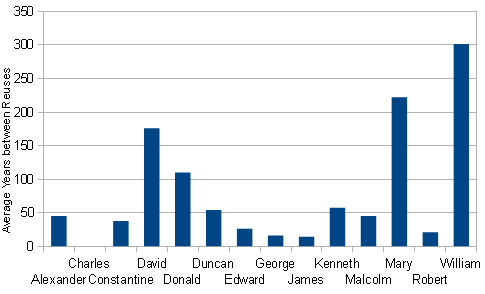Which French monarch name has the longest gap between reuses?
Remember when I calculated the longest gap between reuses for the name for the monarchs of the United Kingdom? Well now I’ve done it for France. The list of French monarchs (on Wikipedia) skips numbers a few times – I think the others with those people aren’t included in the list because they weren’t actually in charge of France, despite stealing a number – and so some gaps are widened by ignoring those people.
Carloman
I d. 771, II s. 879 = 108 years.
Charles
I d. 814, II s. 840 = 26 years.
II d. 877, the Fat s. 885 = 8 years.
the Fat d. 888, III s. 893 = 5 years.
III d. 922, IV s. 1322 = 400 years.
IV d. 1328, V s. 1364 = 36 years.
V d. 1380, VI s. 1380 = 0 years.
VI d. 1422, VII s. 1422 = 0 years.
VII d. 1461, VIII s. 1483 = 21 years.
VIII d. 1498, IX s. 1560 = 62 years.
IX d. 1574, X s. 1824 = 250 years.
Childebert
I d. 558, III s. 695 = 137 years.
Childeric
I d. 481, II s. 673 = 192 years.
II d. 675, III s. 743 = 68 years.
Chilperic
I d. 584, II s. 715 = 131 years.
Chlothar
I d. 561, II s. 584 = 23 years.
II d. 629, III s. 657 = 28 years.
Clovis
I d. 511, II s. 639 = 128 years.
II d. 657, IV s. 691 = 34 years.
Dagobert
I d. 639, III s. 711 = 72 years.
Francis
I d. 1547, II s. 1559 = 12 years.
Henry
I d. 1060, II s. 1547 = 487 years.
II d. 1559, III s. 1574 = 15 years.
III d. 1589, IV s. 1589 = 0 years.
John
I d. 1316, II s. 1350 = 34 years.
Louis
I d. 840, II s. 877 = 33 years.
II d. 879, III s. 879 = 0 years.
III d. 882, IV s. 936 = 54 years.
IV d. 954, V s. 986 = 32 years.
V d. 987, VI s. 1108 = 21 years.
VI d. 1137, VII s. 1137 = 0 years.
VII d. 1180, VIII s. 1223 = 43 years.
VIII d. 1226, IX s. 1226 = 0 years.
IX d. 1270, X s. 1314 = 44 years.
X d. 1316, XI s. 1461 = 145 years.
XI d. 1483, XII s. 1498 = 15 years.
XII d. 1515, XIII s. 1610 = 95 years.
XIII d. 1643, XIV s. 1643 = 0 years.
XIV d. 1715, XV s. 1715 = 0 years.
XV d. 1774, XVI s. 1774 = 0 years.
XVI d. 1792, XVIII s. 1814 = 22 years.
Napoleon
I d. 1815, III s. 1852 = 37 years.
Philip
I d. 1108, II s. 1180 = 72 years.
II d. 1223, III s. 1270 = 47 years.
III d. 1285, IV s. 1285 = 0 years.
IV d. 1314, V s. 1316 = 2 years.
V d. 1322, VI s. 1328 = 6 years.
Robert
I d. 923, II s. 996 = 73 years.
Theuderic
III d. 691, IV s. 721 = 30 years.
The biggest gap is between Henrys, with 487 years between the first and second. The oldest name to be reused is Charles, with 1062 years between the beginning of the reign of Charles I (aka Charlemagne) and the end of the reign of Charles X. Louis is a close second – the first Louis was Charles I’s successor and the last Louis was Charles X’s predecessor – with 1010 years.
As before, I have made a graph showing the average gap size between each name.


